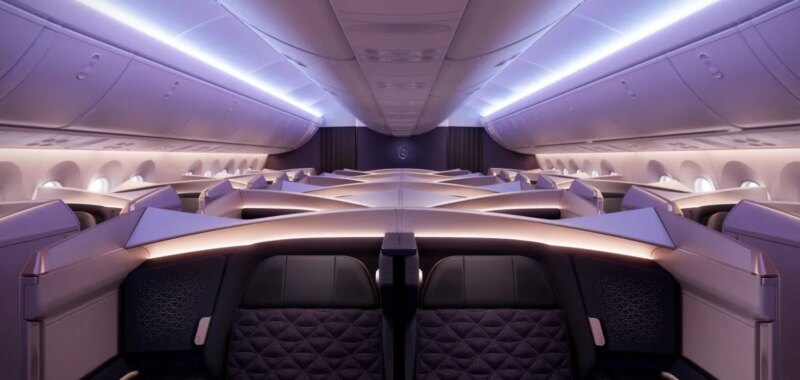Through clunky mergers or simply the test of time, airlines become much more complex as they age. Diverse fleets make for a patchwork of different passenger propositions. Stepping onboard could mean a flagship cabin or something better suited to an aviation museum.
Attempting to correct this disconnect is Riyadh Air. The government-backed Saudi start-up describes itself as âthe no legacy carrier,â and itâs keen to use this distinction to its advantage.
Ahead of its first revenue flight later this year, the company has been leveraging its clean sheet model to rewrite industry norms â but little was known about the passenger experience onboard.
That is all changing Saturday as the airline presents its aircraft interiors for the first time. Speaking to Skift from Riyadh ahead of the reveal, CEO Tony Douglas explained the creative vision behind the project.
âAt Paris Fashion Week in June 2024, we did our cabin crew fashion reveal. I wanted TWA and DiCaprio in âCatch Me If You Canâ, but with a really modern twist. Back in the day, [cabin crew] would walk through the airport and people would stop and look at them. Today, you walk through Heathrow or JFK and most of the cabin crew look the same, in bland grays and dark colors. What we wanted instead was that Audrey Hepburn-esque look with glamor, charm, and grace.â
Designing a series of couture crew uniforms is relatively easy. Translating this design language into the cabin of a large passenger aircraft is quite different.
âWe’ve been working tirelessly to interpret that into the cabin through the art of design,â said Douglas. âIt’s all about detail and nothing that screams out. It’s about subtle details that in some cases are almost subliminal. Cumulatively it all comes together.â

Four Seats; One Vision
Saturdayâs cabin reveal was the result of more than 18 months of top-secret work in collaboration with London-based design agency PriestmanGoode. A total of four seating concepts make up the 290 seats onboard Riyadh Airâs Boeing 787-9 Dreamliner jets. As you might expect, these include economy, premium economy, and business. But thereâs an extra twist in store.
The undisputed star of the show is what Riyadh Air calls Business Elite. Forming just four suites at the very front of the business class cabin, the central pair even convert into a spacious double bed.

The bells and whistles of Business Elite are likely to be headline-grabbing, however, Douglas said that the wider project had more humble beginnings: âWe deliberately started at the back [of the plane] and worked our way forward. Weâve probably all seen airlines where the front cabin looks very premium and the back looks very cheap. It’s almost as if they’re from a different stable. What weâre trying to do through design is make sure that there’s a commonality so you know you’re on Riyadh Air.â
A Popular Seat Design
The business cabin uses Safran Unity seats in a 1-2-1 configuration. These offer a fully flat-bed layout and 52-inch privacy walls. Safran has already won orders for its Unity platform from big-name brands including Japan Airlines and Air India. Qantas is also expected to install the seat onboard its highly anticipated Project Sunrise A350-1000 jets. These are due to link Sydney with both London and New York nonstop from 2027.
Douglas tells Skift that the âcanopy twistâ is the airlineâs signature piece of geometry. Itâs visually striking in isolation but really comes into its own when viewed from the front of the business class cabin.
âBecause they’re underlit and we’ve got variable lighting; when you see all 28 [canopies] together they look absolutely sensational⦠It is unmistakably Riyadh Air. That was always part of the brief. When you go in, once you’ve seen it once, nothing else looks like that. The brand is Riyadh and it’s differentiated visually and impactfully,â he noted.
Riyadh Air Premium Economy
Further back, Riyadh Airâs 39 premium economy seats are in a 2-3-2 layout across six rows. If they look familiar, it’s the same Recaro PL3530 design used by Emirates, albeit with plenty of added extras.
âThe intention was, âHow do we make our premium economy, in all intents and purposes, look better than most business class products in North America and Europe?ââ asked Douglas. âItâs elements such as the cocktail table. It all comes back to the art of design, the mock gold, the choice of materials, the ‘premiumness’ of it. I think most people would probably conclude this is better than many business class products in other parts of the world.â

Further back on the aircraft, the 223 economy seats are in a 3-3-3 configuration, with a competitive 31-inch pitch. Even here there are nods to design and a more upscale feel. Across the 25 economy rows, passengers sitting in the Recaro R3 seats have what Douglas believes is on par with premium economy at some other airlines.
âWe said, right, how do we take the most comfortable seat that we believe to be out there, but through design, through material choices, and through all the subtle bits of detail, lift that cabin such that most people will probably think it’s better than many premium economy cabins?â
To help enforce commonality for connecting passengers, Douglas confirmed that Riyadh Airâs Airbus A321 single-aisle jets will also be kitted out with the same economy seats as those found on the 787: âItâll be exactly the same seat, presented in exactly the same way. When you buy it, you get the same seat. If we’re Riyadh Air, you know what to expect.â

A Digital Focus
As a âdigital-native airline,â the carrier is promising industry-leading technology across all cabins. The 32-inch 4K touchscreen monitors in Business Elite will be among the largest on any commercial airliner, but there are Wi-Fi options too for personal devices.
Riyadh Air is partnering with Viasat to offer free inflight internet for all members of its loyalty program. Saturday’s announcement comes just days after American Airlines said it too would roll out a similar model with the onboard connectivity firm.
Consistency is a priority for Douglas and his team â but is there an appetite for some tinkering around the edges? With up to 72 Boeing 787 aircraft on order, will all of Riyadh Airâs Dreamliners have the same 290-seat configuration?
âI’d never rule anything out, but at the moment our assumption is that all 72 machines will have the same LOPA [Layout of Passenger Accommodations]. Based on all the research we’ve done, it’s the most efficient, the most commercially sustainable, but also the most consistent with what we see as being the guest requirement for the sectors that we’ll operate on,â Douglas added.
How to Maintain the Standard?
Itâs one thing for a new aircraft to look good on day one â but what about after year one, and potentially year six or seven?
âI hate scratches. I hate dents. I hate marks. I hate blemishes. Itâs an obsessional attention to detail with guest experience. Those little things are, for me, the big things,â quipped Douglas.
The British-born executive is a well-known Francophile and loves classic cars. Itâs therefore little surprise that he chooses the term âConcours d’Eleganceâ â literally competition of elegance â to describe how Riyadh Air will keep its cabins looking sharp.
âIf youâve ever seen a classic car presented to Concours d’Elegance standard, they’re quite often in a more mint condition than the day they were built. Like all of those things, if you constantly maintain it, it’s not that difficult.
âWhere so many airlines go wrong is quite often being penny-wise and pound-foolish. They leave [cabins] for three years. By the time they’ve had hard wear and tear, the cost of actually getting them back to standard is disproportionate. It all comes back to that obsessional attention to detail with guest experience.â
To help turn this vision into practice, Douglas reveals that Riyadh Air will have a dedicated team to proactively maintain the cabin interiors and fix snags as close to real-time as possible. The hope is that this will improve the overall aesthetic of the aircraft, but also save money in the long run.
Global Supply Chain Problems
Riyadh Air can dodge many âlegacyâ headaches, but one area thatâs outside of its control is the global supply chain. The company has already been forced to push back its launch date towards the end of 2025. It had initially hoped to be in the air in the first half of the year.
âIn terms of Boeing, first and foremost, weâve had five delivery schedule changes in the last year alone. It’s a dynamic situation which we’re all very familiar with, and itâs no different with Airbus,â Douglas said.

Even once aircraft are assembled, serious delays at companies supplying the cabin interiors can upend overall delivery schedules as he candidly acknowledged: âIf you get away from the big airframers [Airbus and Boeing], the next part is seat manufacturers and cabins in general. Had Boeing delivered to the first issue of the delivery schedule â and clearly they haven’t and they’re not even close to it â the seats would have been late.â
Asked for a real-time update, Douglas confirmed that the seats and the first pair of new Riyadh Air 787s are âphysically in production,â adding that, âwe’re at that stage of evolution where weâre significantly burning down the risk in the supply chain.â
He remains hopeful that the first aircraft will be in the sky towards the end of the year, with three 787s delivered before the start of 2026. Up to eight were part of the original plan.
Whereâs First Class?
Douglas wouldnât be drawn on passengers in the ultra-luxe Business Elite seats being offered an elevated food and drink selection, or receiving other perks on the ground. These details will come in a later announcement.
He did however confirm that the airline is working on something even more special for its next generation of long-haul aircraft.
Riyadh Air is currently reviewing proposals from both Airbus and Boeing for an ultra-widebody jet. Put simply, this means the airline will also fly the A350 or the 777X. The wider fuselage of these aircraft allows airlines to get even more creative, particularly in the premium cabins.

âWe’ll put in a first-class product and what we’d like to do with that, in the same way that we’re resetting the bar for business class, is attempt to reset the bar for first class.â If realized, the introduction of first class would represent a change in approach for the airline.
In this fragile pre-launch phase, the prospect of a third aircraft type joining the Riyadh Air fleet â nevermind the rollout of an industry-leading first class cabin â feels like an ultra-long-haul pursuit.
With an infinite number of moving parts, and several key deliverables outside its direct control, Douglas and his team appear to be taking an increasingly pragmatic approach, at least when it comes to aircraft: âI won’t believe anything until I’ve got my arms around [the first plane] and it is physically on the ground at Riyadh International Airport. What could possibly go wrong? The answer to that question is probably a list as long as my arm.â
Listen to Tony Douglas on the Airline Weekly Lounge podcast:
Airlines Sector Stock Index Performance Year-to-Date
What am I looking at? The performance of airline sector stocks within the ST200. The index includes companies publicly traded across global markets including network carriers, low-cost carriers, and other related companies.
The Skift Travel 200 (ST200) combines the financial performance of nearly 200 travel companies worth more than a trillion dollars into a single number. See more airlines sector financial performance.
Read the full methodology behind the Skift Travel 200.


